Catch Big Bass With Spinnerbaits
"You can't catch big bass with spinnerbaits. It's just not a big bass lure."
Ever heard that said before?
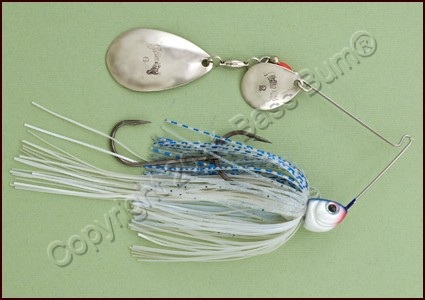

Spinnerbait Techniques For Lunkers
Many anglers, and I mean very good bass anglers, actually think you
can't catch big bass with spinnerbaits. At least they
think a spinnerbait should be the last choice for lunkers. Not so
friends. You need only check the record books or better yet, speak with
a bass angler that has dedicated sufficient time and energy to learning
the nuances of spinnerbaits and knows the appropriate how, when and
where to present them. Jimmy Houston, for example, never fails to impress me with his spinnerbait skills.
However, the spinnerbait does require a good bit of, let's say, situational analysis, before making a choice about what size, style and color might catch big bass on any given day. Why is this? Because there is no one spinnerbait style that will be productive in all situations. It's particularly true when going after trophy bass.
When going after big bass consider the following when choosing a spinnerbait style as the head and blade size, the color of the blades and skirts and blade style will determined by the following criteria.
- Water color, stained, clear, dark.
- Light conditions; cloudy, bluebird sky.
- Water surface; smooth, choppy.
- Primary forage on which bass are feeding.
"Big" Is Better To Catch Big Bass When It Comes To Spinnerbaits
An often stated opinion about big bass is that..." big bass want big lures". While this may be a general truth, it certainly isn't absolute. If it was, the concept of "finesse fishing" would likely never have developed, and we all know finesse techniques produce not only quantity but sometimes quality big bass.
However, with spinnerbaits, fishing larger sizes appear to increase the chances of catching trophy bass over using spinnerbaits that are small.
Whats big?
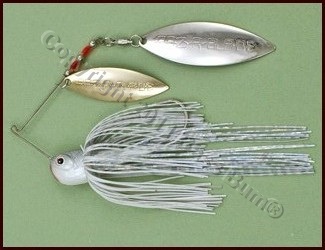
Big Bass Spinnerbaits Are Heavy Spinnerbaits
Spinnerbait heads that are 3/8 or 1/2 ounce are the bottom end of "heavy" while 3/4 ounce heads are the weight that applies to the greatest number of situations. Spinnerbaits used to catch big bass are sometimes used as heavy as 1 ounce to as much as 1 1/2 ounce in weight like the Bottom Dweller spinnerbait Strike King illustrated at right. This is a relatively new design with a head from 3/4 ounce to as much as 1 3/8 ounces. Big head, thin willow leaf blades combine to give the bass angler a spinnerbait that runs deep and stable without rolling to its side, a common problem with many larger spinnerbaits.
Blade sizes, like a #5, #6 or #7, add even more size to a heavy head, sorta like tricking out a "Fat Boy" Harley with all the chrome you can cram on it. Both the Harley and a big spinnerbait are going to get somebody's attention. In the case of the spinnerbait, it will more than likely be the biggest bass within eyesight or that picks up the blade's vibrations.
Smaller bass may be tempted but often have second thoughts about taking it on or defer to the dominant bass in the area.
Head Size and Shape Matter If You're After A Trophy Bass
In clear water the shape, size and color of the lead head also becomes important. Though the blades are a blur to bass the head stays steady and clearly visible so is often the target when struck. So details like eyes, gills and color accents can come to play in drawing a strike, especially from "educated" lunker bass.
The two shown below are examples of manufacturers moving toward a more realistic head profile. Some will argue this is nonsense, but since its a belief held by one of the most successful bass fishermen with a spinnerbait, Kevin Van Dam, I choose to go with it.
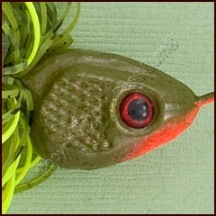 |
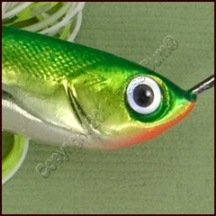 |

Classic Big Bass Spinnerbait Blade Combination's and Techniques
Blade size is a significant part of the spinnerbait, big bass equation, as is whether they are tandem or single on the shaft.
There are several styles and types of spinnerbaits and even more numerous combination of blades and skirts that can be matched to them. However, the workhorse spinnerbait blade combination used most by anglers trying to catch big bass, trophy bass, is a tandem set up, #3 or #4 Colorado blade up front and a large #5 or #6 willow blade behind on a 3/8 ounce head. If you're trying to catch big bass that are active, moving up towards shallow water or in the act of feeding a tandem willow leaf configuration is a good choice as well.
Shallow Water
Be aware that tandem blades displace more water creating more lift so are best suited fishing high in the water column or for shallow bass. The bigger the blades the greater the lift as well. So if you upgrade the "workhorse" combo referenced above to a size #5, #6 or #7 blade in the rear, especially a Colorado, the sucker is going to be trying to jump out of the water if you retrieve it fast. This will be especially true if you're using a light head, say less than 3/4 ounce.
Fish tandems, which are best suited to straight retrieves, just below the surface anywhere from waking to a foot or two below the surface. Since a spinnerbait resembles nothing a bass would eat in its natural world, give it some life on retrieve. Vary your speed, shake your rod a bit or even "kill" it for an instant then start reeling again. Also, don't forget to run it into or through cover. Smack, thump, butt, crash, slam and smash into every piece of isolated cover you can.
That's where the big ones will be. Holding tighter to the most primo isolated cover than a hair in a biscuit and they'll hit it right after the crash.
So, if you're fishing a tandem rig stay in areas like shallow flats targeting isolated stumps or scattered swaths of grass. If the grass is a sheer, almost solid wall of grass you'll have less success than if you're retrieving through the top of scattered grass and "ripping" it each time you feel grass grab hold. Target docks, laydowns even rip rap walls.
A 3/4 ounce spinnerbait with a #3 or #4 Colorado up front and a #5 or #6 willow leaf behind is a good combination for big, shallow water lunkers.
Down Deep
As we all know, big bass, though not strangers to shallow water, much prefer the calm, safe and serene nature of deep water most of the time.
While many use deep diving crankbaits to catch big bass living deep, there are significant limitations on their ability to reach the depths necessary to thump the big bass there. Successful use of deep diving crankbaits requires a close coordination of lure and angler and a lot of energy. Fish a Norman DD22 or a Rapala DT18 or DT20 all day and you'll need more than one beer to ease the pain in your arms and wrists.
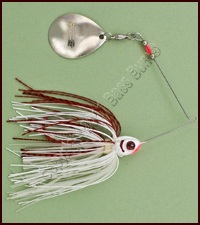
Not so with a big spinnerbait. Straight to the bottom go these gems. They are enticing both in their descent and when snatched off the bottom or slow rolled along the constantly changing undulations of the bottom.
Fish a big spinnerbait where bass congregate on deep structure. If there are small bass on a hump, standing timber, deep grass, (10' to 20') rock piles or brush piles there are likely going to be a big bass or two around too.
On bluff walls helicopter a smaller single Colorado spinnerbait like the BOOYAH at right to catch big bass. The single blade will spin well on the drop creating water turbulence and flash.
Fish spinnerbaits that are big and fish them deep. Mix up your spinnerbait techniques to match conditions and you can catch big bass with a spinnerbait.
Go Back To Big Bass Fishing From Catch Big Bass With Spinnerbaits
